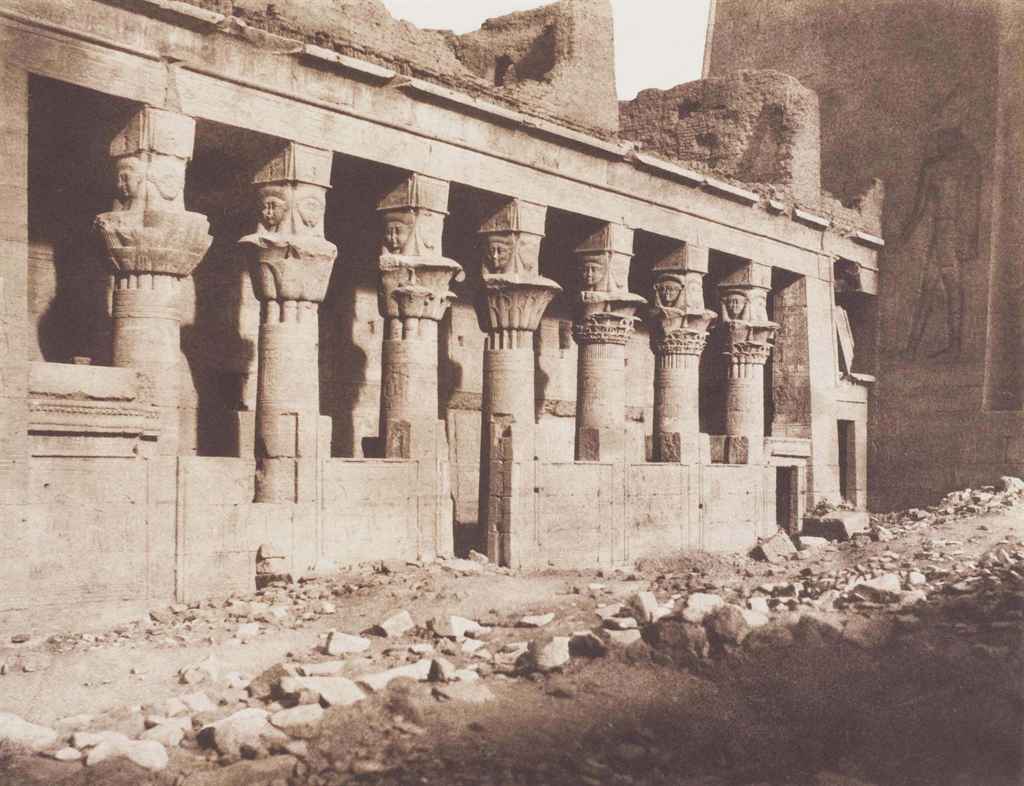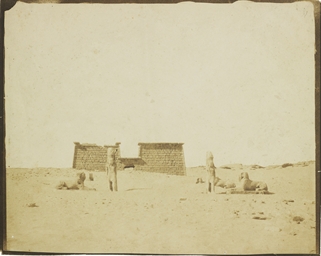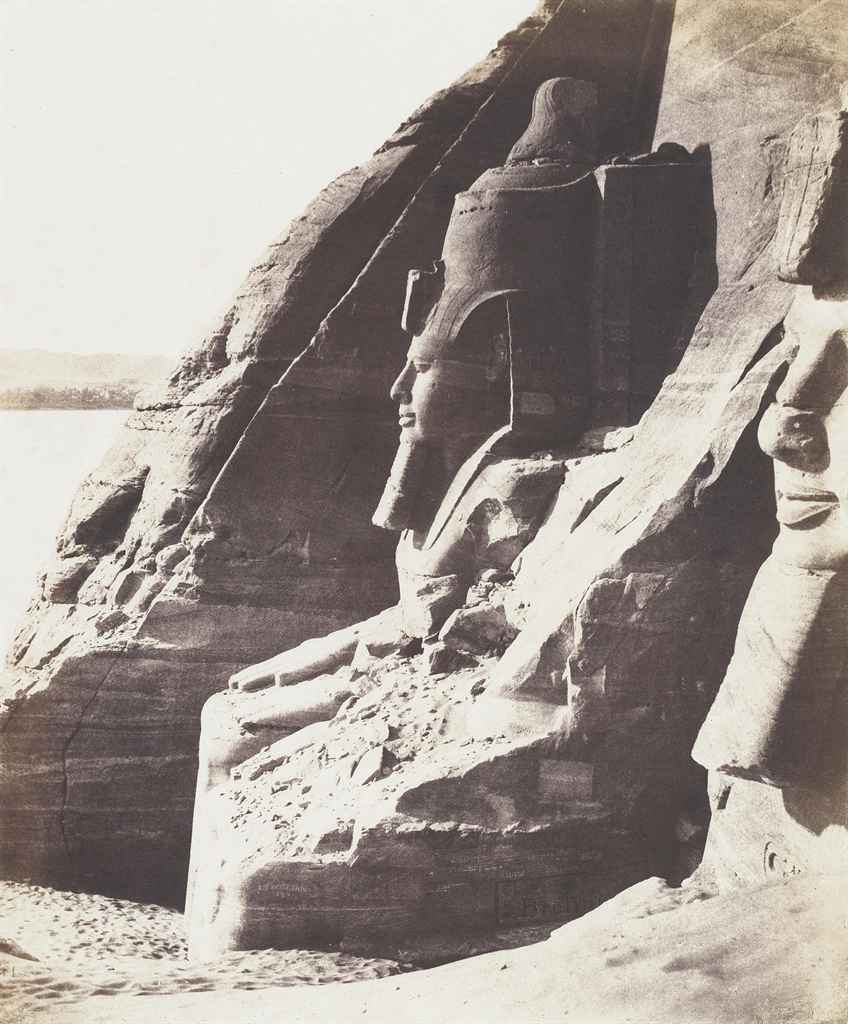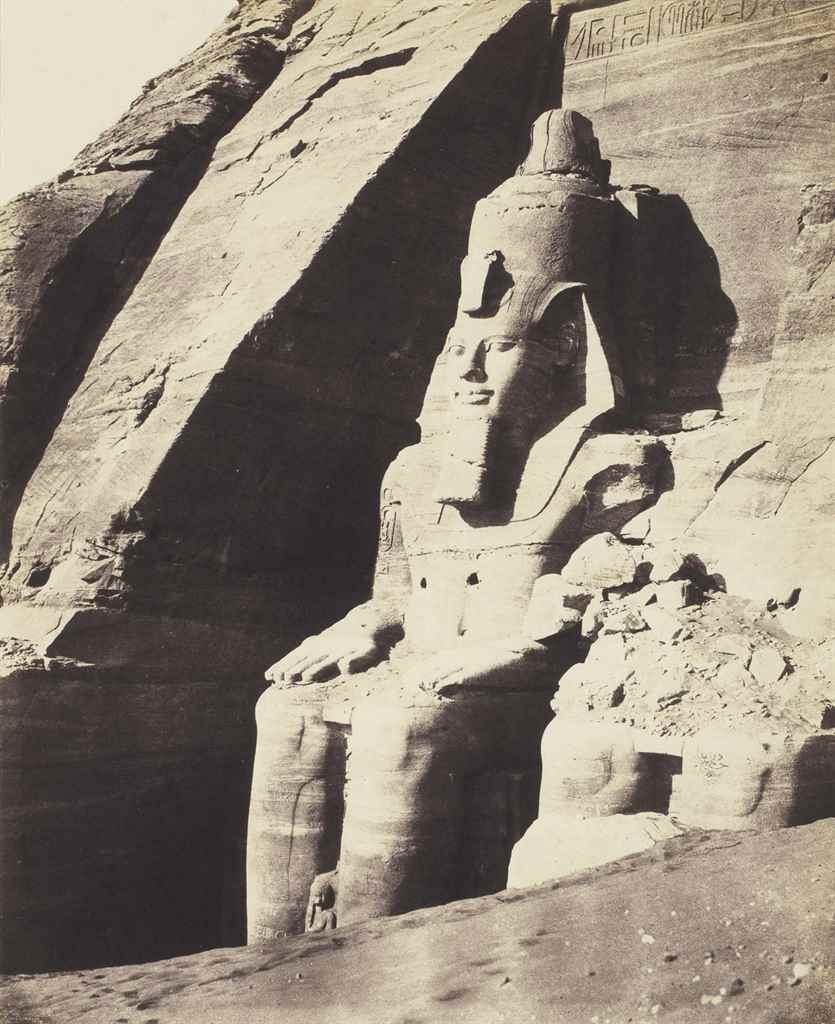Félix Teynard Karnak (Thèbes), Palais - Salle Hypostyle - Vue Transversale Prise du Point K 1851-1852 Salt print. 12 x 10 in. (30.5 x 25.4 cm) Printed credit, title, plate number '56' and publication details on the mount.
Provenance Originally from the Collection of the Marquis du Bourg de Bozas Chaix d'est-Ange Hans P. Kraus, Jr., Fine Photographs, New York Lee Marks Fine Art, Shelbyville, Indiana, 1992 Literature Teynard, Égypte et Nubie: sites et monuments les plus intéressants pour l'étude de l'art et de l'histoire, pl. 56 Howe, Félix Teynard Calotypes of Egypt: A Catalogue Raisonné, pl. 56, there titled Main Temple - Hypostyle Hall - Transverse View Taken From Point K, Karnak (Thebes) Catalogue Essay When French civil engineer Félix Teynard traveled to Egypt in 1851 to photograph along the Nile River Valley, he did so with few photographic predecessors. Equipped with a large-format camera and a supply of paper for negatives, Teynard created the entirety of his photographic oeuvre in 1851 and 1852. These salt prints, among them the present lot, were published serially beginning in 1853, in Égypte et Nubie: sites et monuments les plus intéressants pour l'étude de l'art et de l'histoire. Recalling the complex demands of early photography in a foreign setting, Teynard writes in Égypte et Nubie that “the delicate preparations for photography must be done, sometimes with the lurching of a sailboat, sometimes beneath a tent set up in the middle of the desert.” Despite these obstacles, Teynard produced a body of work distinguished by its modernity. A civil engineer by trade, he was fascinated with the surviving architecture of ancient Egypt as evident in the present lot. The photograph was taken in the Great Hypostale Hall at Karnak, whose roof once spanned 50,000 square feet and was supported by no fewer than 134 columns. In Teynard’s photograph of the ruins, the grandeur of the original structure is palpable. “Teynard’s work of large format is the record of stunned emotion, pure vision and a freedom of the senses rarely so forcibly expressed in early photography,” write André Jammes and Eugenia Parry Janis, “his work is an abstract record of Egypt discovered by the eye” (The Art of French Calotype, p. 249). Read More
Félix Teynard Karnak (Thèbes), Palais - Salle Hypostyle - Vue Transversale Prise du Point K 1851-1852 Salt print. 12 x 10 in. (30.5 x 25.4 cm) Printed credit, title, plate number '56' and publication details on the mount.
Provenance Originally from the Collection of the Marquis du Bourg de Bozas Chaix d'est-Ange Hans P. Kraus, Jr., Fine Photographs, New York Lee Marks Fine Art, Shelbyville, Indiana, 1992 Literature Teynard, Égypte et Nubie: sites et monuments les plus intéressants pour l'étude de l'art et de l'histoire, pl. 56 Howe, Félix Teynard Calotypes of Egypt: A Catalogue Raisonné, pl. 56, there titled Main Temple - Hypostyle Hall - Transverse View Taken From Point K, Karnak (Thebes) Catalogue Essay When French civil engineer Félix Teynard traveled to Egypt in 1851 to photograph along the Nile River Valley, he did so with few photographic predecessors. Equipped with a large-format camera and a supply of paper for negatives, Teynard created the entirety of his photographic oeuvre in 1851 and 1852. These salt prints, among them the present lot, were published serially beginning in 1853, in Égypte et Nubie: sites et monuments les plus intéressants pour l'étude de l'art et de l'histoire. Recalling the complex demands of early photography in a foreign setting, Teynard writes in Égypte et Nubie that “the delicate preparations for photography must be done, sometimes with the lurching of a sailboat, sometimes beneath a tent set up in the middle of the desert.” Despite these obstacles, Teynard produced a body of work distinguished by its modernity. A civil engineer by trade, he was fascinated with the surviving architecture of ancient Egypt as evident in the present lot. The photograph was taken in the Great Hypostale Hall at Karnak, whose roof once spanned 50,000 square feet and was supported by no fewer than 134 columns. In Teynard’s photograph of the ruins, the grandeur of the original structure is palpable. “Teynard’s work of large format is the record of stunned emotion, pure vision and a freedom of the senses rarely so forcibly expressed in early photography,” write André Jammes and Eugenia Parry Janis, “his work is an abstract record of Egypt discovered by the eye” (The Art of French Calotype, p. 249). Read More














Testen Sie LotSearch und seine Premium-Features 7 Tage - ohne Kosten!
Lassen Sie sich automatisch über neue Objekte in kommenden Auktionen benachrichtigen.
Suchauftrag anlegen